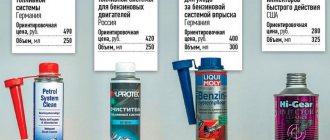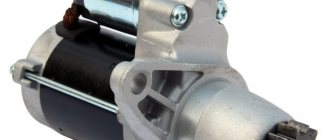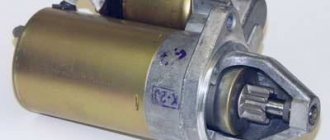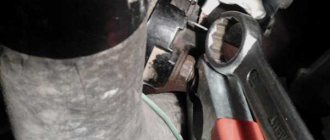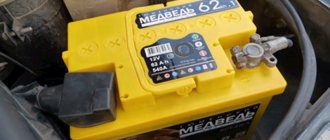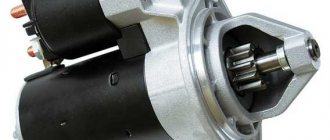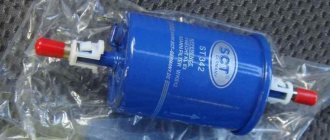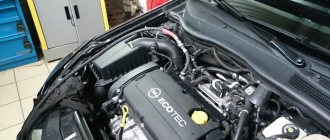Which parts of the starter need to be lubricated?
Before moving directly to the choice of lubricant, it is necessary to decide which internal parts of the starter are to be lubricated. Let's list them:
- starter shaft;
- overrunning clutch;
- gearbox (if available).
As for the starter shaft, its rear part needs to be lubricated to facilitate the movement of the longitudinal clutch. Otherwise, there is a risk of a wedge between the clutch and the gear, which can lead to breakage of their teeth.
Also, some experts recommend lubricating the retractor relay and starter bushings. There are many different opinions on this matter. However, we are of the opinion that it is only necessary to lubricate the shaft, gearbox, and less often the overrunning clutch. You can read about the reasons below.
Maintenance and lubrication of gearbox elements must be performed every 40...50 thousand kilometers or every 2 years (whichever comes first).
Not all starters have a gearbox; it depends on the design and model of the car. Its purpose is to reduce the mechanical forces on the starter, which reduces the current consumption. If the gearbox is not sufficiently lubricated, this will result in excessive load on the associated mechanisms and wear on the battery. Now let's move directly to the question of choosing a lubricant for a car starter.
Starter lubricant must have the following properties:
- wide temperature range of use;
- surface protection from corrosion;
- high load capacity;
- low friction coefficient;
- long term of use.
Possible causes of bendix malfunction
Lada Kalina Sedan my first car Logbook Phase sensor
Replacing the starter bendix is not a cheap job, and the unit itself can cause serious damage to the car owner’s budget. By repairing or replacing it yourself, you can avoid high costs.
The main causes of malfunctions affecting the reliable adhesion of the flywheel and overrunning clutch of the car starter include:
- Formation of deposits inside its body;
- Weakening or breaking of the overrunning clutch roller springs;
- Hull destruction;
- Roller wear.
Some of these faults can be eliminated by repair work; to eliminate others, it will be necessary to replace the starter bendix.
In some cases, repairs come down to soaking the front part of the starter in a container of gasoline and then drying it. Often, after such a procedure, the Bendix Ford Fiesta came into working condition and was not bothered by malfunctions for a long time. In this case, car owners did not even have to think about how to remove the bendix from the starter and put it back.
What lubricant to use for the starter
Before moving on to specific brands, it is necessary to determine what kinematic viscosity a particular lubricant has so that it is suitable for lubricating the starter and its components. According to current standards, the kinematic viscosity of the base oil used to produce starter lubricant must be below 100 cSt (cSt, 1 cT = 1 mm²/s). Such compositions are intended for operation in conditions of very low temperatures, high speed of interaction of rubbing metal or other pairs and low mechanical load.
If the oil has a kinematic viscosity in the range of 100...200 cSt, then such compositions belong to the class of general automotive ones . They are designed to operate at medium temperatures, medium speeds, and light to medium loads. You will find information about kinematic viscosity on the packaging of the lubricant that you plan to use for the starter. However, remember that lubricants with a viscosity of 100...200 cSt are not suitable for use in starter elements . This statement is based on the fact that the minimum operating temperature is -20...25°C. Examples of such lubricants are MC-1000, RAVENOL Hot Red Grease HRG2, LIQUI MOLY LM 47. Therefore, for many parts of our country this indicator is not enough, since in winter the temperature drops much lower (the exception, of course, is the southern regions).
Do not confuse base oil viscosity with consistent viscosity (NLGI). For cars, lubricants with the NLGI-2 index (soft lubricants) are most often used.
An excellent lubricant option for starter elements is LIQUI MOLY Thermoflex . It belongs to the class described above with a kinematic viscosity of up to 100 cSt. In particular, at a temperature of +40°C it has a viscosity of 18 cSt. Its additional advantage is the fact that it can work not only with metal, but also with plastic parts. Its analogue is RAVENOL Arctic Green Grease AGG2 with an operating temperature range from -60°C to +120°C.
There is no universal answer to the question of what kind of lubricant to lubricate the starter with. However, there are several common options that motorists use today. First of all, it depends on the air temperature at which you plan to operate the machine. In particular, to what minimum temperature does the temperature in your region drop in winter?
Among other cheaper means used, the following are popular:
- "Litol 24";
- Graphite grease;
- Castrol LMX (155ED3);
- “Ciatim 201”;
- Lubricants for CV joints.
When choosing a particular lubricant, you need to know its characteristics, first of all, the operating temperature range. After all, the composition must ensure normal operation of the mechanism both in severe frost and in heat. Next, we will analyze in more detail the characteristics of the listed compositions.
"Litol 24"
This lubricant is very popular among car enthusiasts and is in many ways universal. It can lubricate conductive elements and various moving metal pairs. The temperature range is from -40°C to +120°C. As for viscosity, it is 8 Pa s at +50°C and 650 Pa s at -20°C. This is quite enough to ensure normal operation of the starter in the specified temperature range. “Litol” is suitable for places located in mid-latitudes (it is better not to use it in the far north). "Litol 24" is excellent for lubricating gearboxes.
Graphite grease
The temperature range for use of this composition is from -20°C to +60°C. Therefore, such a small range imposes some restrictions on the scope of use of such lubricants. It can be used in hot regions, and also if you do not want to overpay for more expensive lubricants.
Castrol LMX LI-KOMPLEXFETT 2
It is a grease consisting of a lithium complex thickener. It has good water resistance and adhesion to metal surfaces, high load capacity and thermal stability. Castrol LMX grease has a lower temperature range of -35°C, and an upper temperature range of +170°C. Therefore, many car owners use it to lubricate the gear starter.
"Ciatim-201"
This is an anti-friction frost-resistant instrument lubricant. It can be used in friction units operating with low shear force at low loads, in aviation equipment, radio equipment, electromechanical and other devices and precision mechanisms, including in automotive technology. It is a frost and moisture resistant lubricant. This old, proven product can also be used as a lubricant for the Bendix starter and its other elements. Its distinctive feature is the lower temperature operating limit, which is -60°C. Upper - +90°С. Therefore, “Ciatim-201” is excellent for use in northern latitudes.
CV joint lubrication
There are many of these tools. However, their common positive property is that they have a large operating temperature range. On average, from -30°C to +120°C, although in some cases its boundaries may be different (depending on the specific lubricant). Best suited for lubricating the starter shaft. You also need to understand that the original CV joint lubricants are designed to work under heavy loads, so in winter conditions they will not work the best.
How to lubricate the starter
Let's consider this process using the example of lubrication of a VAZ classic starter. To do this, you must first remove the unit from the car. To do this, use a 13 key. To perform lubrication, it is necessary to disassemble the starter, but not completely, as is done during repair or maintenance work. That is, it is necessary to provide access to the starter shaft (for other machines it is also necessary to get to the gearbox). The work takes place in the following sequence:
Checking and lubricating the starter on a VAZ 2114
- Unscrew the contact bolt nut and remove the starter winding terminal.
- Remove the solenoid relay by first unscrewing its three mounting bolts.
- Pick it up and remove the spring from it. After this, remove the anchor itself from the cover.
- Remove the starter cover from the back of the starter by first unscrewing the two mounting bolts. Remove the shaft retaining ring and washer to free the armature shaft.
- Unscrew the two fastening bolts and disconnect the rotor from the housing. Disconnect the stator winding from the armature. After this, remove the insulating tube from the inside of the stator.
- Separate the housing and stator cover from each other. Remove the jumper from the brush holder. Remove the stator brushes and springs.
- Using a mandrel, press out the rear bearing (also known as the rear bushing). To remove the clutch from the front, you need to remove the anchor. To do this, disengage the fastening arms.
- Remove the lock washer using a screwdriver. Similarly, remove the retaining ring using two screwdrivers, unclamping it.
- Remove the coupling from the rotor shaft. You can proceed directly to lubricating the worm joint.
- For this purpose, you can use various means described above. In this case, it is important for you to know that before lubrication you need to clean the surface of old grease, and lubricate the worm joint itself generously so that the solenoid relay operates normally even in frosty weather.
When disassembling the starter and lubricating its parts, we recommend that you conduct a complete preventive inspection.
List of tools required for repair
To repair a starter, approximately the same set is required, depending on the model and manufacturer of the unit. The table below provides an indicative list of tools that will be needed for repairs.
Table - Tools required to replace the front strut
This is interesting: Replacing the low beam lamp on a Nissan JUKE, photo and video instructions
| Name | Note |
| TORX head | Required mainly when repairing starters from foreign cars |
| Head | “at 8”, “at 10”, “at 12”, “at 13”, “at 14”, “at 15”. Size varies depending on the make and model of starter. |
| open-end wrench | For access where a socket or spanner cannot reach |
| Vorotok | With ratchet and extension |
| Multimeter | To check the electrical parameters of the starter |
| Cardan for wrench | Required if access to the starter or wire mounts is difficult |
| Screwdriver | With flat or cross blade. On foreign cars, a specially shaped tip is sometimes required, for example, a flat one with a notch or an “asterisk” |
| Insulating tape | To restore insulation |
| Penetrating lubricant | For loosening stuck threaded connections |
| Rags | For cleaning dirt and grease residues |
In order to repair a faulty starter, it is recommended to purchase a special repair kit. It includes the main elements of the assembly that are most susceptible to wear. Sometimes such a repair kit includes some of the tools necessary to restore the functionality of the unit.
The best starter lubricant
We will try to systematize the information and provide you with a table that provides information on which lubricant is best to use for the planetary starter gearbox, as well as its shaft. We are not trying to impose our vision, but only present the information that we managed to find .
| Lubrication units | Lubricant requirements | Examples of lubricants |
| Planetary reductor | Long-lasting, compatible with plastic parts and elastomers, resistance to high mechanical loads, wide operating temperature range |
|
| Starter shaft | Providing low friction coefficient, high load-bearing capacity, liquid resistance and corrosion protection, wide temperature range. |
|
| Overrunning clutch | Wide temperature range, compatibility with various machine couplings, resistance to oxidation and humidity, protection against corrosion of working surfaces, long-term use. |
|
Surely, based on the information provided, it will be easier for you to make your choice. After all, there are a lot of opinions on the use of certain lubricants on numerous forums. There are also differing opinions regarding the general advisability of lubricating individual starter components. Let's talk briefly about this below.
So does the starter need to be lubricated?
On numerous forums on the Internet, there are different opinions on whether certain parts of the starter need to be lubricated. It’s worth saying right away that the planetary gearbox . By doing this you will only contribute to its normal operation. For this purpose, it is better to use: from expensive lubricants LIQUI MOLY Thermoflex or RAVENOL Arctic Green Grease AGG2, from cheap ones - “Litol 24”, graphite lubricant, CV joint lubricants. Also, the choice should be based not only on price, but also on operating temperature.
As for the gearbox shaft , for this it is better to use the above-listed Molykote 3400A Leedfree, Molykote BR 2 Plus, graphite lubricant, Castrol LMX, “Ciatim 201”. The choice again depends on price and temperature conditions.
Some car enthusiasts use WD-40 as a lubricant. However, we do NOT recommend that you do this, since this product is not inherently a lubricant and can damage the starter elements.
Starter solenoid relay lubrication
There is an opinion that it is necessary to lubricate the copper-graphite bushings on the armature axis. Actually this is not true ! Their normal sliding is facilitated by graphite, which is powder applied to their working surface. As you know, graphite is excellent for gliding. At the same time, dirt does not accumulate on it.
Regarding the question of how to lubricate the starter solenoid relay and its armature, there is a recommendation not to lubricate it at all . The fact is that the lubricant in this place collects various dirt on itself, forming a dense mud layer, which undoubtedly harms the normal operation of the Bendix. And if this same lubricant thickens in the cold, then this will be all the more harmful for the mentioned elements of the starter and threatens emergency operation until it completely fails.
What's the result?
Thus, the selection of lubricant for the starter largely depends on the operating conditions of the machine. In particular, it depends on the frost in which she drives. The main thing is that the lubricant is always of normal consistency. to do a preventive inspection of the starter every 40...50 thousand kilometers or every 2 years and lubricate its shaft and planetary gearbox. But lubricating the shaft where the bendix moves or the solenoid relay not only makes no sense, but is also harmful. Copper bushings are also included in the list of non-lubricated parts, but are only subject to wear control.
Brush unit
To access the brush assembly, the starter must be disassembled as shown in the image below.
The first thing you should check is how the brushes move in the brush holders. If there are jams, the defective areas should be sanded.
Brushes need to be inspected for melting and thermal damage. Particular attention must be paid to the point of contact with the collector. Minor defects can be removed by sanding.
During operation, the brushes wear out. The critical size ranges from 4 mm to 15 mm depending on the design. If this is achieved, the brushes need to be replaced. Their price ranges from 90 to 1800 rubles, depending on the brand and model of the starter.

